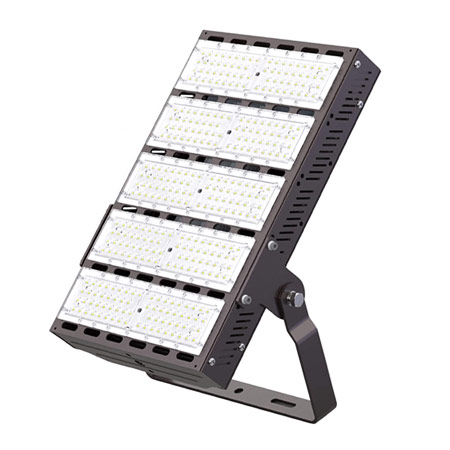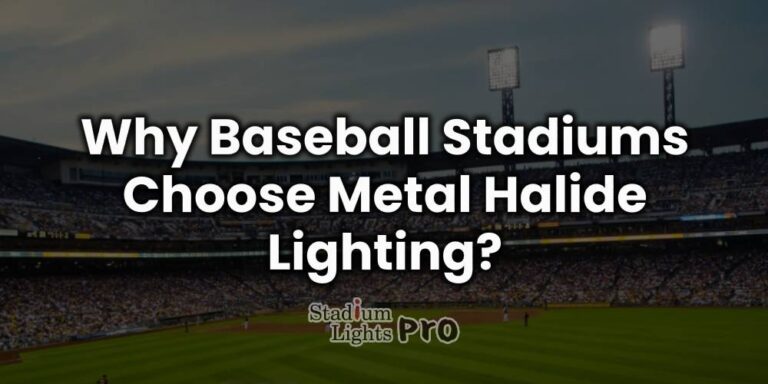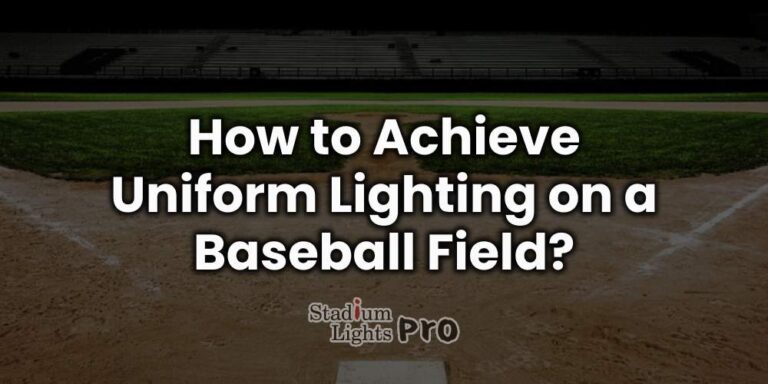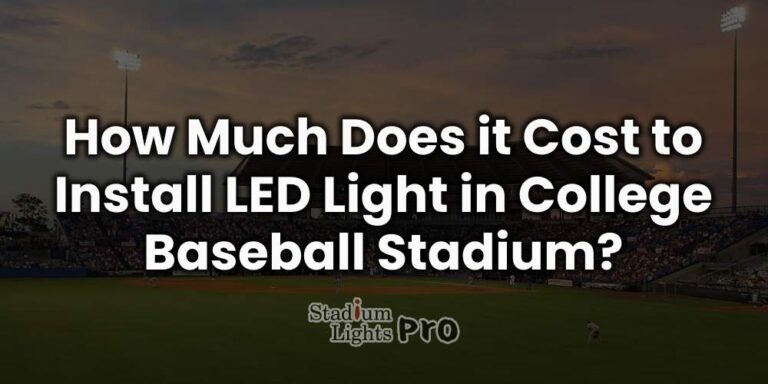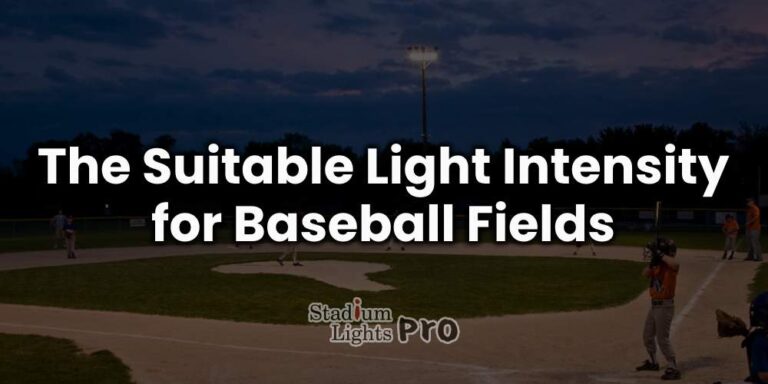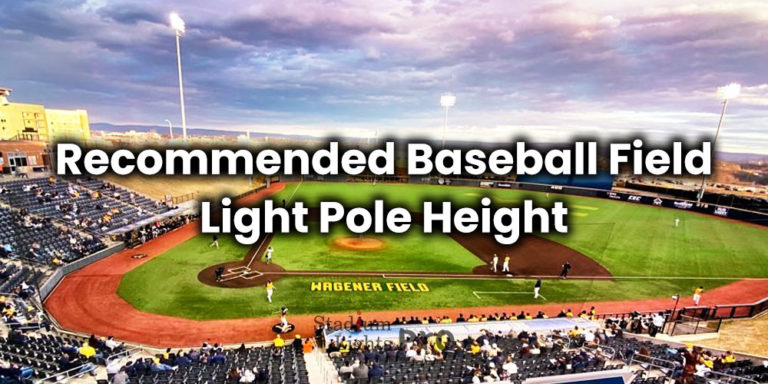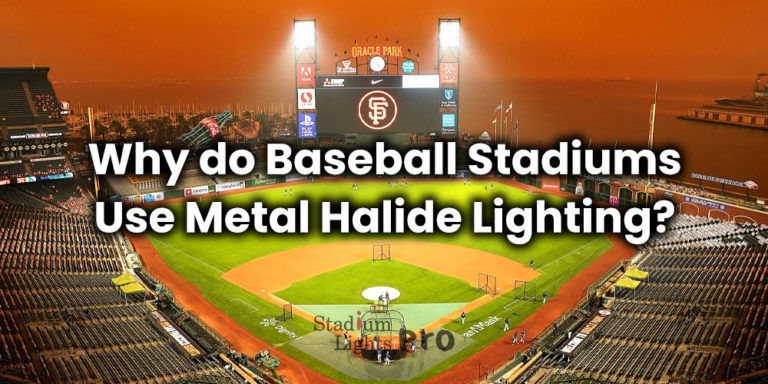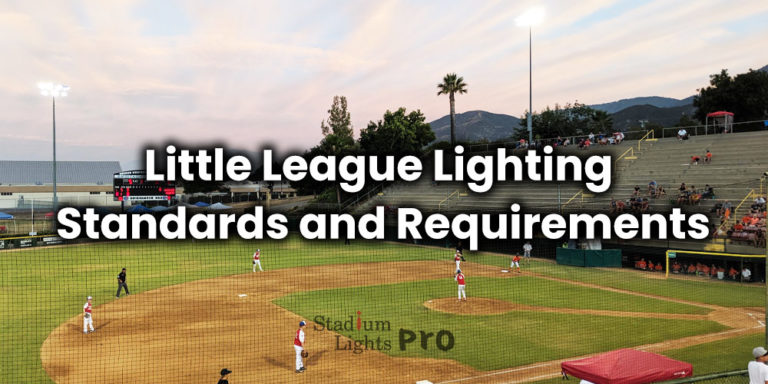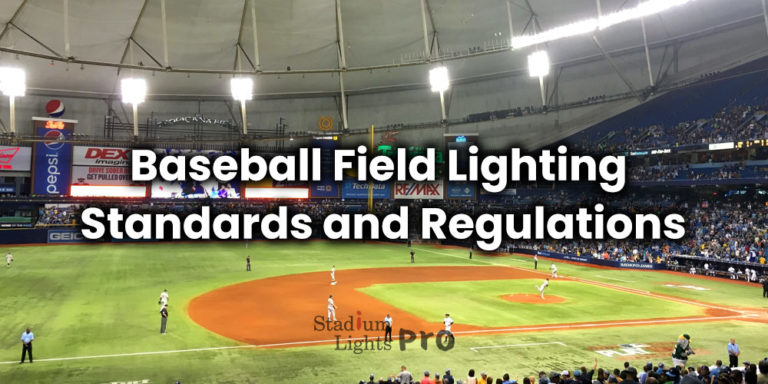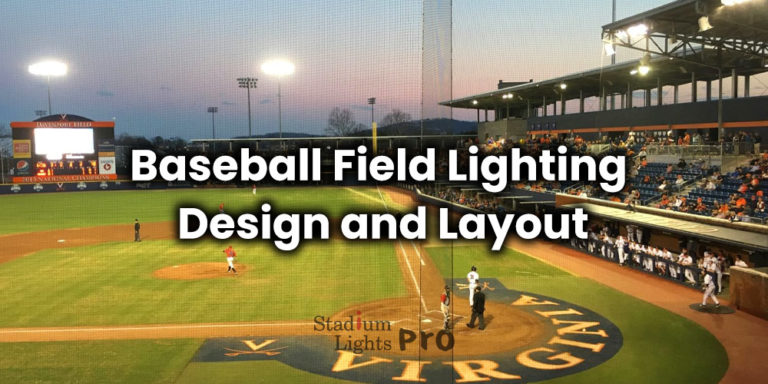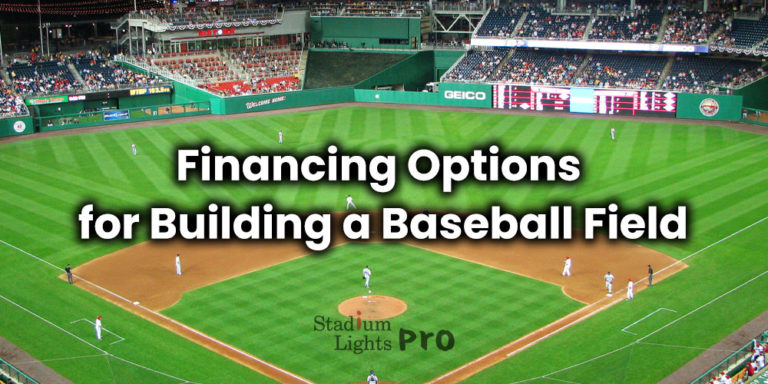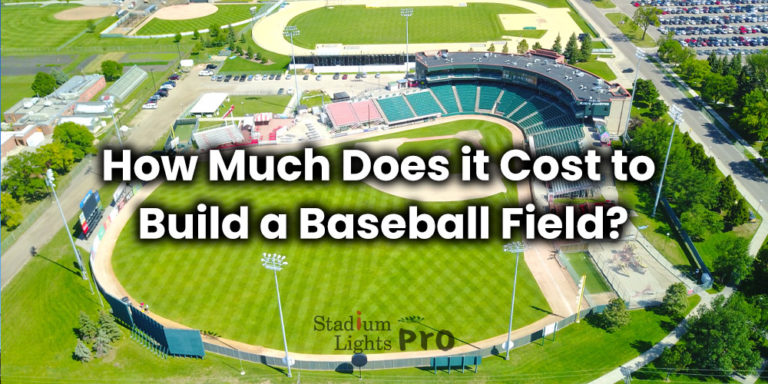
Baseball Field Lighting
Welcome to our page on baseball field lighting! Baseball fields require specialized lighting in order to provide adequate visibility for players, coaches, and spectators. Proper lighting not only enhances the safety and enjoyment of the game, but it also allows for televised broadcasts and night games.
In this page, we will explore the various factors that go into designing and installing lighting for a baseball field. We will discuss the cost of lighting, lighting design and layout, grants and financing options, and other considerations. Whether you are a coach, player, or just a fan of the game, this page will provide valuable information on how to ensure that your baseball field has the best lighting possible.
- Cost – Installing lighting for a baseball field can be a significant investment, and it is crucial to have a clear understanding of the costs involved before making a purchase. This page will provide information on the various factors that affect the cost of baseball field lighting, such as the size of the field and the type of lighting system being installed.
- Lighting design and layout – The layout and design of the lighting system can have a major impact on the effectiveness and efficiency of the lighting. By reading this page, you will learn about the different design considerations that should be taken into account when planning a lighting system for a baseball field.
- Grants and financing options – There may be grants or financing options available to help offset the cost of installing baseball field lighting. We will provide information on the various options that may be available to help you fund your lighting project.
- Other considerations – There are many other factors to consider when installing lighting for a baseball field, such as the type of bulbs and fixtures to use, and the maintenance required to keep the lighting system in good working order. By reading this page, you will learn about these and other essential considerations that should be taken into account when planning your lighting project.
Contact us for a free lighting consultation
Lighting is crucial in baseball for a number of reasons. Firstly, it allows for the game to be played at night or in low light conditions, which is necessary due to the length of time a baseball game can take and the limited daylight hours during certain times of the year.
Additionally, lighting is essential for creating a safe and fair playing environment. Adequate lighting is necessary for players to see the ball, field, and each other, and to react appropriately to the game. Poor lighting can lead to accidents and injuries, and can also create an unfair advantage for one team if one side of the field is better lit than the other. Proper lighting is therefore crucial for the safety and fairness of the game.
Table of Contents
ToggleThe challenges of designing and maintaining effective baseball field lighting
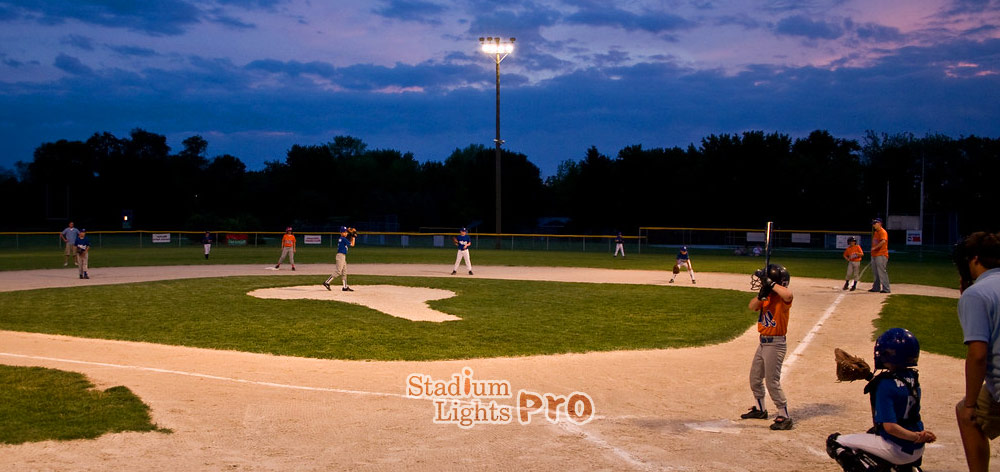
Achieving the right balance between brightness and energy efficiency
The lights need to be bright enough for players to see the ball and field clearly, but using too much energy can be costly and unsustainable.
Ensuring uniform lighting across the entire baseball field
Shadows and glare can create distractions and impair visibility for players, so it is essential to evenly distribute the light and eliminate any hotspots or areas of darkness.
Maintenance of the baseball field lighting system
The lights and fixtures are exposed to the elements and can suffer from wear and tear over time, so regular maintenance is necessary to ensure that the system is functioning properly. This can be time-consuming and costly, and requires trained personnel to perform the necessary repairs and replacements.
The history of baseball field lighting
Early use of lighting in baseball
First recorded use of lighting in a professional baseball game (1930)
The first recorded use of lighting in a professional baseball game occurred on April 17, 1930, at Crosley Field in Cincinnati, Ohio. The game, which was between the Cincinnati Reds and the Philadelphia Phillies, was the first Major League Baseball (MLB) game to be played under lights. The game was a success, and it paved the way for the wider adoption of lighting in professional baseball.
Before this, lighting was only occasionally used in baseball for exhibition games or special events. The development of lighting technology in the 20th century made it possible for regular season games to be played at night, and today, all 30 MLB teams have installed lights at their home stadiums.
Limited adoption of lighting in the early 20th century
The adoption of lighting in professional baseball was slow in the early 20th century. One reason for this was the limited availability of lighting technology at the time. The first recorded use of lighting in a professional baseball game occurred in 1930, but it wasn’t until the 1970s that metal halide lamps became widely used in baseball field lighting. These lamps were brighter and more energy-efficient than the incandescent bulbs that were previously used, but they still required a lot of energy and were expensive to operate.
Another reason for the limited adoption of lighting in baseball was the cost of installing and maintaining a lighting system. Baseball stadiums are large, and the cost of installing and maintaining a lighting system was prohibitive for many teams. It wasn’t until the 1980s that all 30 MLB teams had installed lights at their home stadiums.
The evolution of lighting technology in baseball
Introduction of metal halide lamps in the 1970s
The introduction of metal halide lamps in the 1970s marked a significant step forward in the development of baseball field lighting. Metal halide lamps are a type of high-intensity discharge (HID) lighting that use a gas discharge process to produce light. They are brighter and more energy-efficient than incandescent bulbs, which were the main type of lighting used in baseball stadiums prior to the 1970s.
The use of metal halide lamps allowed for brighter and more even lighting on the field, which improved the visibility and safety of the game. It also made it possible for games to be played in low light conditions, such as during the twilight hours or on overcast days. The adoption of metal halide lamps in baseball was a major milestone in the evolution of lighting technology in the sport.
LED lighting becomes more widespread in the 21st century
In the 21st century, LED (light-emitting diode) lighting has become more widespread in baseball field lighting. LED lights are more energy-efficient and have a longer lifespan than metal halide lamps or incandescent bulbs, which makes them an attractive option for lighting systems.
LED lights also offer improved color rendering and uniformity, which can enhance the appearance of the field and the player’s uniforms. They are also more durable and have a faster switch-on time, which can be beneficial in certain situations.
Many professional baseball teams have switched to LED lighting in recent years, and it is now the most common type of lighting used in baseball stadiums. The adoption of LED lighting in baseball is an ongoing process, and it is expected that more teams will make the switch in the coming years.
Major milestones in the development of baseball field lighting
First Major League Baseball (MLB) night game (1935)
The first Major League Baseball (MLB) night game was played on May 24, 1935, at Cincinnati’s Crosley Field. The game, which was between the Cincinnati Reds and the Philadelphia Phillies, was the first regular season MLB game to be played under lights. The game was a success, and it paved the way for the wider adoption of lighting in professional baseball.
Before this, lighting was only occasionally used in baseball for exhibition games or special events. The development of lighting technology in the 20th century made it possible for regular season games to be played at night, and today, all 30 MLB teams have installed lights at their home stadiums.
First World Series game played under lights (1971)
The first World Series game to be played under lights took place on October 13, 1971, at Baltimore’s Memorial Stadium. The game, which was between the Baltimore Orioles and the Pittsburgh Pirates, was the first World Series game to be played at night. The game was a success, and it marked a significant milestone in the evolution of baseball field lighting.
Before this, all World Series games were played during the day. The development of lighting technology in the 20th century made it possible for regular season games to be played at night, and the first MLB night game was played in 1935. However, it wasn’t until the 1970s that lights were installed at enough stadiums to make it possible for the World Series to be played at night. Today, all World Series games are played under lights.
All 30 MLB teams have installed lights (1987)
All 30 Major League Baseball (MLB) teams had installed lights at their home stadiums by 1987. This marked a significant milestone in the evolution of baseball field lighting, as it made it possible for all regular season games to be played at night.
The adoption of lighting in professional baseball was slow in the early 20th century due to the limited availability of lighting technology and the cost of installing and maintaining a lighting system. The first recorded use of lighting in a professional baseball game occurred in 1930, but it wasn’t until the 1970s that metal halide lamps became widely used in baseball field lighting. In the 21st century, LED lighting has become more widespread in baseball field lighting. Today, all MLB teams have lights at their home stadiums, and all World Series games are played under lights.
Designing a baseball field lighting system
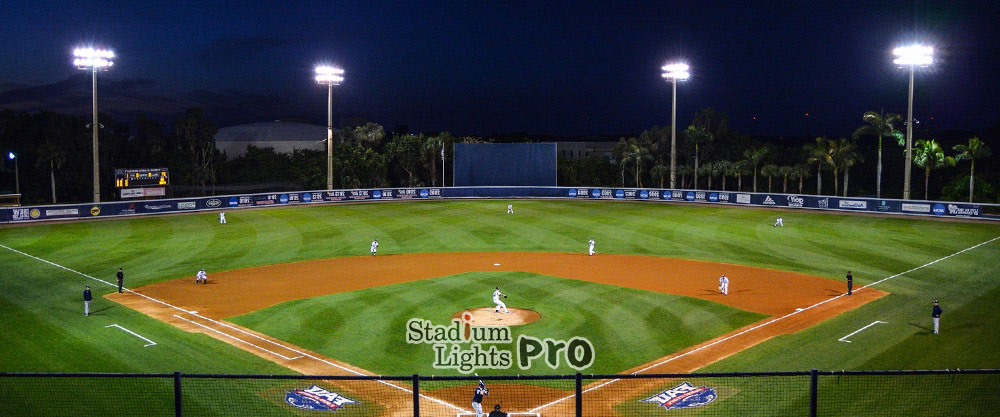
Factors to consider when designing a baseball field lighting system
Size and layout of the field
The size of the field will determine the number and placement of light poles needed to adequately light the entire area. The layout of the field, including the positions of the bases, home plate, and foul poles, will also need to be taken into account to ensure that the lights are positioned in a way that maximizes visibility and minimizes shadows and glare.
Height and positioning of the light poles
The poles need to be high enough to provide sufficient light to the entire field, but not so high that they create shadows or glare. The poles should also be positioned in a way that minimizes shadows and maximizes visibility.
Light poles for baseball field lighting are typically between 70 and 80 feet tall. The exact height will depend on the size and layout of the field, as well as the type and brightness of the lights being used. The poles should be spaced evenly around the perimeter of the field, with additional poles placed in the center field area if needed.
The positioning of the poles should also take into account the location of the stands and other structures around the field, as well as the sight lines of the players and umpires. We need to plan the placement of the poles to ensure that they do not obstruct the view of the game or create distractions for the players.
Brightness and color temperature of the lights
The brightness of the lights determines how well players can see the ball and field, and is therefore a crucial safety factor. The color temperature of the lights, which is measured in degrees Kelvin (K), affects the appearance of the field and the player’s uniforms.
Baseball field lighting should have a brightness of at least 300 lux (a unit of luminous flux) to meet the minimum light levels required for safe play. The color temperature should be around 5000K, which is a neutral white color that provides optimal visibility for players.
Brightness and color temperature are often related to the type of light being used. Incandescent bulbs and metal halide lamps are typically warmer in color (lower color temperature), while LED lights can offer a wider range of color temperatures. We may consider the brightness and color temperature of the lights when designing a baseball field lighting system to ensure that the system is effective and meets the needs of the players.
Uniformity of lighting across the baseball field
Uniform lighting means that the light is evenly distributed across the entire baseball field, with no hotspots or areas of darkness. This is essential for creating a safe and fair playing environment, as shadows and glare can impair visibility and create distractions for the players.
To achieve uniform lighting, it is necessary to use multiple rows of lights around the perimeter of the field and to position the poles evenly around the field. The lights should also be aimed correctly to minimize shadows and maximize visibility. Using multiple rows of lights can help to eliminate hotspots and create more even lighting across the field.
Uniformity is also affected by the brightness and color temperature of the lights. We need to use lights with consistent brightness and color temperature to ensure that the lighting is even across the field. LED lights can offer improved uniformity compared to other types of lighting, as they tend to have a more consistent output and can be more easily controlled.
Energy efficiency and cost considerations
Lighting a large outdoor area like a baseball field can be energy-intensive, and it is suggested to consider the long-term cost of operating the system.
One way to improve the energy efficiency of a baseball field lighting system is to use LED lights, which are more energy-efficient and have a longer lifespan than other types of lighting. It is also recommended to carefully design the lighting system to minimize the number of lights needed and to position the lights in a way that maximizes their effectiveness.
In addition to energy efficiency, we need to consider the upfront cost of installing the lighting system, as well as the ongoing maintenance costs. It is generally more cost-effective to invest in high-quality lighting equipment that has a longer lifespan and requires less maintenance, rather than opting for lower-cost equipment that may need to be replaced more frequently.
Tips for maximizing the effectiveness of a baseball field lighting system
Use higher wattage lights to increase brightness
Using higher wattage lights is one way to increase the brightness of a baseball field lighting system. Wattage is a measure of the power of a light bulb or fixture, and higher wattage lights produce more light than lower wattage lights.
However, we need to consider the trade-off between brightness and energy efficiency when using higher wattage lights. Higher wattage lights will consume more energy, which can increase the cost of operating the lighting system and may have an impact on the environment.
In general, it is recommended to use the highest wattage lights that are practical and cost-effective, within the limits of energy efficiency. Higher wattage lights will provide more brightness, which can improve visibility and safety on the field, but it is necessary to consider the long-term costs and environmental impact of using higher wattage lights.
Aim for a color temperature of around 5000K for optimal player visibility
It is recommended to aim for a color temperature of around 5000K for optimal player visibility in baseball. This color temperature is a neutral white color that provides good contrast and visibility, and it is similar to the color temperature of natural daylight. A color temperature of around 5000K is generally considered to be the best balance between visibility and appearance.
Use multiple rows of lights to achieve better uniformity
Using multiple rows of lights is one way to achieve better uniformity of lighting across a baseball field. Uniform lighting means that the light is evenly distributed across the entire field, with no hotspots or areas of darkness.
To achieve uniform lighting, it is necessary to use multiple rows of lights around the perimeter of the field and to position the poles evenly around the field. The lights should also be aimed correctly to minimize shadows and maximize visibility. Using multiple rows of lights can help to eliminate hotspots and create more even lighting across the field.
Maintaining a baseball field lighting system
The importance of regular maintenance
Ensuring the safety of players and spectators
Adequate lighting is necessary for players to see the ball, field, and each other, and to react appropriately to the game. Poor lighting can lead to accidents and injuries, and can also create an unfair advantage for one team if one side of the field is better lit than the other.
Prolonging the lifespan of the lighting system
There are several steps that can be taken to prolong the lifespan of a baseball field lighting system. One way to extend the lifespan of the system is to use high-quality lighting equipment that is designed to withstand the elements and has a longer lifespan. It is generally more cost-effective to invest in higher-quality equipment that requires less maintenance and has a longer lifespan, rather than opting for lower-cost equipment that may need to be replaced more frequently.
Another way to prolong the lifespan of the lighting system is to properly maintain the equipment. This includes regular inspections and cleaning of the lights and fixtures, as well as replacing any damaged or worn parts. Proper maintenance can help to prevent costly repairs and downtime, and can help to ensure that the system is functioning properly.
It is necessary to follow the manufacturer’s recommendations for the use and maintenance of the lighting equipment. This includes following the proper operating procedures and using the equipment as it is intended to be used. Adhering to the manufacturer’s recommendations can help to prolong the lifespan of the lighting system and ensure its optimal performance.
Maintaining optimal lighting performance
One way to ensure optimal performance is to regularly inspect and clean the lights and fixtures. Dirt, debris, and other contaminants can accumulate on the lights and fixtures over time, which can reduce their effectiveness and shorten their lifespan. Regular cleaning can help to prevent this and ensure that the lights are functioning at their best.
Another way to maintain optimal lighting performance is to replace any damaged or worn parts as needed. This can include bulbs, ballasts, and other components that may become damaged or fail over time. Replacing these parts can help to prevent costly repairs and downtime, and can help to ensure that the lighting system is functioning properly.
Common problems of baseball field lighting and how to troubleshoot them
Baseball field bulbs burning out or failing
Baseball field bulbs can burn out or fail for a variety of reasons. One common reason is simply due to the age of the bulb. Bulbs have a limited lifespan and will eventually burn out, regardless of how they are used.
Another reason that bulbs may burn out or fail is due to improper use or handling. For example, if a bulb is bumped or dropped, it may become damaged and fail. Bulbs may also fail if they are subjected to extreme temperatures, high humidity, or other harsh conditions.
Bulbs may burn out or fail due to a malfunction in the lighting system. This can include problems with the ballast (the device that regulates the current to the bulb) or other components of the system.
Regardless of the reason for the failure, we need to replace any failed or burnt out bulbs as soon as possible to ensure the optimal performance of the lighting system.
Corrosion of baseball light poles or fixtures
Corrosion of baseball light poles or fixtures can occur due to a variety of factors. One common cause of corrosion is exposure to the elements, particularly saltwater or salt spray. If a baseball field is located near the ocean or in an area with high levels of salt in the air, the light poles and fixtures may be more prone to corrosion.
Another cause of corrosion is exposure to acidic substances, such as acid rain or industrial pollution. If a baseball field is located in an area with high levels of air pollution, the light poles and fixtures may be more prone to corrosion.
Corrosion may occur due to a lack of maintenance or the use of low-quality materials. If the light poles and fixtures are not regularly inspected and maintained, or if they are made of low-quality materials that are prone to corrosion, they may become damaged over time.
To prevent corrosion, it is highly recommended to use high-quality materials and to regularly inspect and maintain the light poles and fixtures. It is also helpful to use protective coatings or other measures to protect the poles and fixtures from the elements.
Electrical issues
Electrical issues can be a common problem in baseball field lighting systems. Some of the most common electrical issues include:
Circuit overload
If too many lights are turned on at the same time, it can cause an overload on the circuit, leading to a power outage or damage to the system.
Power surges
Power surges can cause damage to the lighting system, particularly to the bulbs and ballasts.
Loose connections
Loose connections can cause problems with the power supply to the lights, leading to flicker or failure of the lights.
Wiring problems
Wiring problems, such as frayed or damaged wires, can cause problems with the power supply to the lights.
To prevent electrical issues, we need to ensure that the lighting system is properly installed and maintained, and to use high-quality wiring and components. It is also helpful to use surge protectors or other protective devices to guard against power surges. If electrical issues do occur, we should address them promptly to prevent further damage to the system.
Baseball field & stadium lighting frequently asked questions
How many foot-candles of light are required for a baseball field?
According to the NCAA, a minimum of 50 foot-candles is required for collegiate games, and a minimum of 70 foot-candles is recommended. High school games generally require at least 30 foot-candles.
How high should baseball field lights be?
The height of the light poles for a baseball field can vary, but a common range is 70-80 feet. The higher the lights, the larger the area they can cover, but it also increases the chance of light spillage into neighboring properties.
How many watts per square foot are needed for baseball field lighting?
This can vary depending on the desired foot-candles and the reflectivity of the surface being lit. As a rough estimate, you may need around 10-20 watts per square foot to achieve 50 foot-candles, and around 15-25 watts per square foot to achieve 70 foot-candles.
Can I use solar-powered lights for a baseball field?
Solar-powered lights can be used for a baseball field, but they may not be the most practical or cost-effective choice. Solar-powered lights typically do not provide as much light as traditional grid-powered lights, and they may not be able to meet the foot-candle requirements for a baseball field. Additionally, solar-powered lights may not be reliable in cloudy or overcast conditions.
How much does it cost to install baseball field lights?
The cost of installing baseball field lights can vary widely depending on the size of the field, the height of the poles, the type of lights used, and other factors. We can expect to pay $100,000 or more for a full lighting system.
How do I calculate the number of lights needed for a baseball field?
To calculate the number of lights needed for a baseball field, you will need to consider the size of the field, the desired foot-candles, the wattage of the lights, and the spacing between the poles. Here is an example of how you can calculate the number of lights needed for a baseball field:
Assume that the size of the field is 300 feet by 400 feet, and you want to achieve 70 foot-candles.
You will also need to know the wattage of the lights and the desired spacing between the poles. Let’s say you are using 1000 watt lights and you want to space the poles at 100 feet intervals.
First, calculate the total wattage needed for the field by multiplying the square footage of the field by the desired foot-candles and the watts per square foot needed to achieve those foot-candles:
300 ft x 400 ft x 15 watts/sq ft = 180,000 watts
Next, divide the total wattage needed by the wattage of each light to determine the number of lights needed:
180,000 watts / 1000 watts/light = 180 lights
Next, divide the length of the field by the desired spacing between the poles to determine the number of rows of lights needed:
400 ft / 100 ft = 4 rows
To cover the width of the field, you will need at least 4 rows of lights with 45 lights in each row. However, you may need additional lights depending on the actual layout and the desired light level uniformity. A lighting design professional can help you determine the exact number of lights needed and the best layout for your specific field.
How do I maintain baseball field lights?
To maintain baseball field lights, you should regularly inspect the lights and poles for any damage or wear and tear. You should also clean the lights and lenses regularly to ensure they are functioning at their best. Additionally, you should make sure the lighting control system is working properly and test the emergency backup system regularly.
Can I use LED lights for a baseball field?
Yes, LED lights can be used for a baseball field. LED lights are more energy efficient and have a longer lifespan than traditional metal halide or high pressure sodium lights, which can make them a more cost-effective choice in the long run. However, they may be more expensive upfront.
What are the benefits of using LED lights for a baseball field?
Some benefits of using LED lights for a baseball field include:
Energy efficiency
LED baseball field lights use less energy than traditional lights, which can result in lower energy bills.
Long lifespan
LED lights have a longer lifespan than traditional lights, which can result in lower maintenance costs.
Better color rendering
LED lights can provide better color rendering than traditional lights, which can make it easier for baseball players to see the ball and make plays.
Improved safety
LED lights can turn on and off more quickly than traditional lights, which can improve safety in emergency situations.
How do I choose the best lights for my baseball field?
When choosing the best lights for your baseball field, you should consider factors such as the size of the field, the desired foot-candles, the wattage of the lights, the spacing between the poles, and the budget. You may also want to consider the energy efficiency and lifespan of the lights. A lighting design professional can help you make the best choice for your needs.
Can I install baseball field lights myself?
Installing baseball field lights can be a complex and potentially dangerous task that requires specialized knowledge and equipment. It is generally recommended to hire a professional lighting contractor to install baseball field lights. A professional will have the necessary expertise and resources to safely and properly install the lights, ensuring they are installed to meet code requirements and operate safely.
Are there any code requirements for baseball field lighting?
Yes, there are code requirements for baseball field lighting. These requirements may vary by jurisdiction, but they generally include standards for the number of foot-candles required, the height and spacing of the light poles, and the wattage of the lights.
Conclusion
Effective baseball field lighting is essential for creating a safe and fair playing environment, and it requires careful design and maintenance. Brightness, color temperature, uniformity, energy efficiency, and cost are all crucial factors to consider when designing a lighting system. Proper maintenance, including regular inspections and cleaning of the lights and fixtures, can help to prolong the lifespan of the system and lower maintenance costs. By carefully planning and maintaining the lighting system, it is possible to create a high-quality playing environment for baseball players and spectators.
If you are in need of expert design and consultation for your baseball field or stadium lighting, look no further! Our team of professionals has extensive experience in creating top-quality lighting systems for baseball fields and stadiums. We are dedicated to providing the best possible solutions to meet your specific needs and budget.
Don’t hesitate to contact us to learn more about how we can help you get the best lighting design for your baseball field or stadium. Whether you need assistance with a new installation or are looking to upgrade your existing lighting system, we have the expertise to help you achieve your goals. Our team is here to provide expert consultation and guidance to ensure that you get the best lighting solution for your needs. Contact us today to get started!

